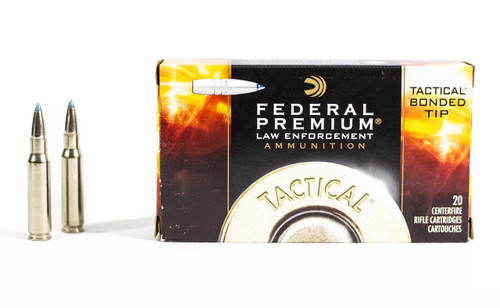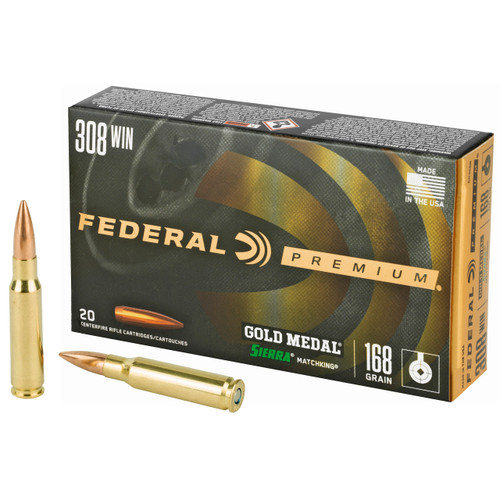.308 Ammo

.308 Winchester: In Depth
In the early 1940s, the much-loved M1 Garand service rifle was dutifully blasting .30 caliber bullets at the enemies of the United States all over the world. The rifle’s ammunition, 30-06 Springfield, was powerful, but heavy; the gun was a self loader, but only carried 8 rounds in its en bloc clip. While it displayed remarkable performance in combat, a sizable contingent of soldiers considered it outdated – or at least in need of an update.
In fact, before the Second World War was over, the Army had already begun looking for ways to significantly improve upon the M1; specifically, to address the weight complaints, the low capacity, and the lack of automatic firing capability. Before long, the war had finished without any substantial change to the rifle; the hefty M1 would remain the USA’s primary small arm for more than a decade afterward with its bulky 30-06 Springfield ammunition in tow.
Early in the post-war period, the formation of NATO, along with accompanying discussions of wartime logistics, led its member nations to cry out for standardizing small arms ammunition. The hunt had begun for a suitable rifle cartridge – one that everyone could agree on, no less.
Over the next several years, continued experimentation with a shortened version of the 30-06 Springfield round was proving fruitful for the US in their development of a successor to the to both the M1 and its cartridge, and domestic gun manufacturers were following along with keen interest.
In 1952, Winchester seized on the opportunity and introduced a new commercial cartridge that was nearly identical to the military round in development for NATO. Calling their creation the .308 Winchester, they marketed it as a hunting cartridge alongside a .308-chambered version of their own Model 70 bolt-action rifle.
Miraculously (and through a bit of persuasion on the part of the US), this cartridge was also agreed upon as the new NATO standard (designated 7.62x51mm NATO) in 1954. It differed slightly from the commercial .308 Winchester, both in case thickness and in the rifles’ chamber dimensions – with the NATO chambers being slightly longer for reliability reasons – but they were, and continue to be, basically interchangeable.
The long-awaited and “improved” version of the M1, known as the M14, was finally adopted by the US military in 1957 and featured a lighter overall package, a 20-round detachable-box magazine, selective fire capability, and (of course) fed the new 7.62x51mm NATO cartridge. Its tenure as main battle rifle was short-lived, however, as the M-16 would replace it in the mid 60s.
Another cartridge-defining rifle would come out just five years later, in 1962 – the Remington 700. Though chambered in many different calibers and cartridges, the Remington 700 has done much to bolster .308 Winchester’s reputation in particular as one of the preeminent hunting rounds in the US over the last seventy-plus years.
The following decades witnessed the .308 Winchester and 7.62x51mm NATO rounds become even more firmly installed into the military, law enforcement, and hunting spheres. The first broad use of .308 Winchester in an official military sniping platform dates to 1965 and the M40 rifle, with police and SWAT units following suit with their own sniper programs afterwards using the M24. Later, in the 90s, Eugene Stoner’s return to the AR-10 designs of the 50s and 60s led to the SR-25, a sign that the .308 “battle rifle” was still a valid concept. Additionally, many shooters in the last few decades have taken advantage of inexpensive polymer-stocked hunting rifles that chamber .308 Winchester. These rifles, along with the massive availability and effectiveness of the ammunition, have helped to secure .308 Winchester’s place in the modern shooting landscape.
.308 Winchester Guns
A lifetime of NATO military service (that shows no signs of losing vigor), along with its storied reputation as one of the USA’s favorite hunting cartridges, has ensured the widespread availability of .308 Winchester firearms. Shooters can take their pick from lightweight / minimalist rifles to heavy target guns, bolt action, semi-auto, mag-fed service (“battle”) rifles, and military surplus firearms. Additionally, if your budget and location allow, you may also explore the availability of transferable NFA weapons, particularly machine guns.
Bolt Action Hunting Rifles
- Winchester Model 70
- Remington 700
- Savage Axis / Axis II
- Ruger American
- Tikka T3x
- Bergara B-14
- Howa 1500
Semi-Automatic Hunting Rifles
- Benelli R1 Big Game
- Browning BAR Mark III
Target / Competition Rifles
- Ruger Precision Rifle
- Savage 110
- Masterpiece Arms BA PMR Pro Rifle II
Service Rifle / Civil Defense
- Springfield M1A
- Knights Armament SR-25
- Aero Precision M5E1
- FN SCAR 17
- PTR Industries PTR-91
Why .308 Winchester?
This round is part of an exclusive club, having been a NATO service cartridge (as 7.62x51mm NATO) since the 1950s, and a beloved hunting cartridge for just as long. To this day, the .308 Winchester remains supremely versatile and universally available.
Hunting
- As a hunting cartridge, .308 Winchester has ample energy to dispatch game and is lighter to lug around than 30-06 Springfield. This goes for the rifles you’ll be shooting, too: the actions are shorter and therefore weigh less than long actions (7mm Rem. Mag., 30-06 Springfield).
- Recoil is manageable, even in a lightweight platform (such as a Savage Axis II or Ruger American), compared to the unpleasant shooting 7mm Rem. Mag. or even 30-06 Springfield.
- Wide variety of hunting loads available for varmint, predator, and medium-sized game hunting.
- Accurate, lightweight, and inexpensive hunting rifles chambered in .308 Winchester – sometimes even with a scope – are commonplace in major retailers across the US.
Target / Competition
- Larger case capacity and bigger bullets compared to .223 Remington / 5.56 NATO means better wind performance.
- 168-grain and 175-grain HPBT rounds have a long history of winning matches.
- Many purpose-built target rifles chambered in .308 Winchester offer surprisingly good accuracy right out of the box.
Training / Home / Civil Defense
- Abundance of 147-grain and 150-grain FMJ “ball” ammo on the market.
- More energy than .223 Remington / 5.56 NATO yet still dependable in a semi-auto platform like the AR-10.
.308 Winchester: Ammo Brands and Loadings
Brands
- US Manufacturers: Federal, Winchester, Remington, Hornady, Browning, Nosler, Underwood, Barnes
- Imports: PPU (Prvi Partizan), PMC, IMI, S&B (Sellier and Bellot), Lapua
Standard Loadings
- Original 7.62x51mm NATO load was a 144-150-grain FMJBT bullet @ 2,750/fps2, this load is still the most common range ammunition and sold with either .308 Winchester or 7.62x51mm NATO specifications.
- Hunting loads commonly have a 150-grain bullet @ 2,820/fps
- Match / Target loads tend to feature a 168-grain or 175-grain HPBT bullet @ 2,650-2,700/fps.
Bullet Types
- FMJ (Full Metal Jacket) - Training, target, military surplus ammo
- Polymer-Tip / Ballistic Tip - Hunting, target
- JSP (Jacketed Soft Point / Interlock / Core-Lokt) - Hunting
- HPBT (Hollow Point Boat Tail) - Match, target, training
Bullet Weights
- FMJ (Full Metal Jacket) - 145-grain to 150-grain (185-grain to 200-grain subsonics)
- Polymer-Tip / Ballistic Tip - 110-grain to 178-grain
- JSP (Jacketed Soft Point / Interlock / Core-Lokt) - 150-grain to 180-grain
- HPBT (Hollow Point Boat Tail) - 150-grain to 185-grain
Velocities
- The vast majority of commercial ammo delivers somewhere between 2,600/fps to 2,900/fps.
- Subsonic ammo is one exception @ 1,050/fps.
Subsonic Ammo
- Several manufacturers offer factory-made subsonic ammo for use with suppressors. Most loads feature a 200-grain FMJ bullet @ 1,050/fps.
Go Deeper on the .308
If you’d like even more information about .308 Winchester, consider checking out these books, articles, and forum discussions:
Books
Web
.308 Winchester FAQ:
Technically no, but they are so similar that most people use them interchangeably in their guns. There are, however, rare circumstances where it may be unsafe to shoot .308 Winchester in a 7.62x51mm NATO chambered-barrel.
Yes, you can shoot 7.62x51mm NATO out of a .308 Winchester barrel. It’s perfectly safe.
Yes, you can shoot .308 Winchester out of a 7.62x51mm NATO barrel – most of the time. You might want to think twice if it’s an older semi-auto military surplus rifle, specifically if it has no firing pin retraction system, since this might lead to an out-of-battery firing2, especially if soft primers are used in the ammunition. .308 Winchester brass is also thinner than NATO brass so it’s theoretically possible to develop higher pressures. Bottom line, when used in a high-quality rifle manufactured in the last few decades, there’s nothing to worry about.
When shot through an accurate rifle by a capable shooter, any well-made ammunition fits this description. In order to find the most accurate shooting load for your particular gun, you may have to try several of them at the range.
If you’re shooting heavy (175-grain and above) bullets and not getting acceptable accuracy, it’s possible that the barrel is not stabilizing the bullet (see FAQ on barrel twist rate).
In North America, the cartridge is frequently used on white-tailed and mule deer, even elk5. It is sometimes used to hunt moose and black bear as well. Lighter-weight bullets can be used for varminting purposes (110-grain to 130-grain). The AR-10 and similar platform semi-auto rifles are favored by hog hunters across the US. These rifles tend to be chambered in short-action cartridges; particularly .308 Winchester.
Your choice is most often between a 1:12 twist and a 1:10 twist. While both are great for stabilizing most bullets, if you plan on shooting heavier bullets – let’s say 175-grain and above – the 1:10 is a better option. The really heavy 200-grain subsonic loads won’t stabilize at all with a 1:12 twist barrel.







